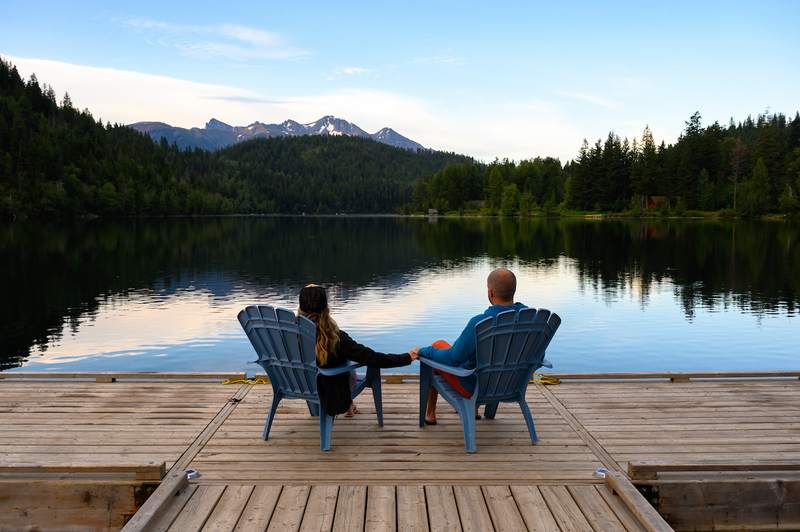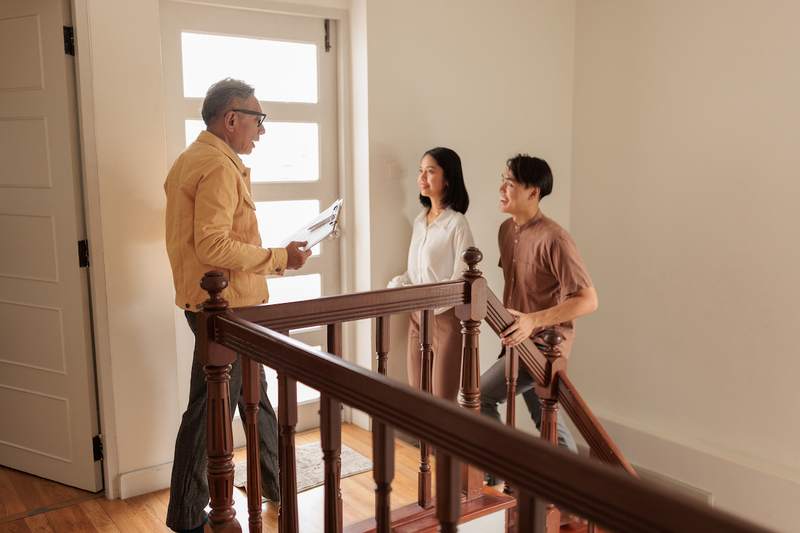The American dream may still be to own a home, but for some families, that home is smaller now. If you’ve grown tired of writing big checks for your rent or mortgage, you may have considered saving money by downsizing to a tiny house.
There are many reasons why folks have embraced tiny houses, such as wanting to maintain less square footage or own fewer things. Although you may know about tiny houses through reality television shows from the past decade like “Tiny House Nation” and “Tiny House, Big Living,” small living spaces aren’t a new concept.
John Kernohan, co-founder and chairman of the United Tiny House Association, an organization based in Eatonton, Georgia, that supports the tiny-house movement, says the demand for tiny houses grew after the Great Recession of 2008. The economic crisis motivated people to downsize their lifestyles, and similarly, interest in tiny homes has spiked again amid the coronavirus pandemic. According to Kernohan, 2020 marked a resurgence in the popularity of tiny homes.
Buying a tiny house isn’t the right move for everyone, though. If you’re looking to slash your living expenses by joining this growing wave of homeowners, here’s what you need to know:
- What Is a Tiny House?
- How Much Does a Tiny House Cost?
- Where To Buy a Tiny House
- Financing a Tiny Home
- Additional Costs of Owning a Tiny House
- Is a Tiny House Right for You?
- The Bottom Line on Buying a Tiny House
What Is a Tiny House?
Tiny houses are much smaller than the average American single-family home built in 2020, which was about 2,300 square feet. So, how big is a tiny house? Tiny houses are typically 400 square feet or less, and may have wheels or a foundation.
Accessory dwelling units, another type of tiny house, provide an opportunity for homeowners to add a second, smaller home to their single-family lot.
“These allow property owners to offer affordable housing solutions in their community and provide the homeowners with a new revenue stream,” Kernohan says.
How Much Does a Tiny House Cost?
One of the biggest perks of tiny houses is that they are less expensive than larger, single-family homes.
“Tiny houses have become an easy and affordable solution to owning one’s house and owning it quickly,” says Kernohan, who has been living in a 304-square-foot tiny home with his wife, Fin, since 2011.
But just like with traditional homes, the average cost of a tiny house varies depending on whether you’re buying or building it.
Cost to buy a tiny house
The cost of buying a tiny house is influenced by the kinds of bells and whistles that come with it. According to HomeAdvisor, a home project platform, tiny houses typically cost between $30,000 to $60,000, with an average price tag of $45,000. However, depending on the amenities, tiny houses can cost as little as $8,000 or as much as $150,000 — or even more.
While costs will vary depending on where you live and other factors, here are some comparisons based on the national averages for buying a single-family home vs. a tiny house:
Comparing Costs Between Traditional Homes and Tiny Houses
| Cost | Single-family home | Tiny house |
| Average purchase price | $391,900 (includes cost of land) | $45,000 (cost of purchasing or renting land is additional) |
| Utilities | $2,060 per year | $480 to $600 per year |
| Homeowners insurance | $1,249 per year | $600 to $1,200 per year |
| Property taxes | Less than $200 to more than $10,000 per year | Varies depending on tiny-house parking situation |
Cost to build a tiny house
If you’re willing, you can learn how to build a tiny house with free plans, or plans that cost under $100. Of course, you’ll have to purchase building materials — like lumber, siding, roofing, and more — which Kernohan says can start around $12,000 to $20,000 for a basic tiny house.
Alternatively, you can pay a company to help build your tiny house. For example, Tiny House Basics, which manufactures tiny-house trailers, offers tiny-house shells for $19,699 and up. Wiring a tiny house costs roughly $500 plus labor, and hiring a professional to add plumbing costs $100 to $200 per hour plus materials and other fees. Depending on your expertise, you can either complete the house on your own or hire a contractor to finish the job.
According to HomeAdvisor, building a tiny house on a foundation costs an average of $51,000 to $53,000, though total costs can range from $35,000 to upward of $68,000 — and that doesn’t include purchasing land. Still, it’s generally less expensive to build a tiny house than it is to purchase a comparable one that has already been built.
Keep in mind that the demand for building materials has increased in 2021, and prices have risen significantly as a result. With a labor shortage and disruptions in the supply chain, be prepared for price fluctuations and delays if you’re planning to build a tiny house.
Where To Buy a Tiny House
You could search for finished tiny houses and shells through resources like Tiny House Listings or Tiny House Marketplace. Kit homes are also an option, which come with blueprints and the necessary supplies — though it’s advisable to have construction experts involved.
If you’re looking for a custom project, Small House Society has a directory of designers and builders who specialize in tiny houses. There are tiny-house architects across the U.S., so it’s likely you can locate one in your area.
Financing a Tiny Home
Figuring out how to buy a tiny house can be tricky. Most dwellings, especially ones on wheels, won’t qualify for a mortgage. Even so, you might be eligible for other financing options, such as:
- A personal loan through your bank or credit union.
- A recreational vehicle loan (if your tiny house is on wheels).
- Financing directly through a tiny-house builder like Tiny Heirloom.
- A home equity loan (if you currently own a home).
Regardless of which option you choose, lenders will review your finances to determine your eligibility and the loan amount, interest rate and terms.
Example of financing a tiny house
Using a personal loan with an interest rate of 10%, here’s an example of what financing a $45,000 tiny house might look like:
- Loan amount: $45,000
- Interest rate: 10%
- Loan term: Five years
- Monthly payment: $956.12
- Total interest paid: $12,367
In this financing example, the total amount paid is $57,367.
Additional Costs of Owning a Tiny House
Before diving into tiny-house living, you should craft a budget to estimate your expenses. Here are some hidden costs you’ll need to consider.
Transportation and towing
You might need to call a professional towing service to move your home. Depending on the size of your tiny house, where you’re moving to and the time of year, you could pay up to $3.25 per mile, according to Rocky Mountain Tiny Houses, which builds and delivers tiny houses on wheels.
Renting or purchasing land
If you don’t own land, you must pay for tiny-house parking, which is the term for renting a place to put your tiny house. Such parking may be located in RV parks, backyard co-ops, or resort-style communities. Pricing depends on the location and amenities needed to run your tiny house, like hookups for electricity, water, sewer and septic systems, and internet.
Kernohan says those amenities could be covered by your tiny-house parking fees, but that isn’t always the case. As an example, tiny-house parking in a RV park can cost between $300 and $1,200 per month, according to Tiny House Expedition, a platform that advocates for the tiny-house movement.
If you don’t want to rent, the cost of purchasing land for your tiny house depends on the location as well as other factors. Keep in mind that owning a tiny house means that you must also pay property taxes.
Tiny-house appliances
With significantly limited space in a tiny house, you may want to opt for portable or custom appliances instead of standard sizes. For example, a tiny-house electric refrigerator can cost anywhere from $150 to $3,000 or more. You should also budget for eventual repairs, which costs an average of $172 for each appliance, according to HomeAdvisor.
Home insurance
Tiny-house insurance premiums cost around $600 annually but can range from $400 to $1,500 per year, according to Policygenius, an online insurance marketplace.
Like with a single-family home, the cost to insure a tiny house depends on multiple factors. However, purchasing insurance for a tiny house can be more complicated because standard homeowners insurance might not cover these dwellings. You may need to purchase a mobile home insurance policy instead, depending on the insurer’s requirements for coverage. Make sure to shop around and check with different providers on their policies for tiny houses.
Is a Tiny House Right for You?
Buying a home is a big decision — even when it’s a tiny house. There are some benefits and drawbacks to consider before investing your money in this type of property.
Tiny-house pros
Here are several advantages of buying a tiny house:
- Affordability: Tiny houses are generally cheaper to buy than larger, traditional homes. “Areas throughout the country with housing issues have recognized tiny homes as a viable solution for the affordable housing crisis in their communities,” Kernohan says.
- Easier maintenance: You have fewer areas to maintain with a tiny house due to the reduced square footage. “Less space means less time cleaning,” Kernohan says.
- Eco-friendliness: If you’re worried about your carbon footprint, a tiny house almost always requires less energy than a traditional home. According to Constellation, an energy company, a tiny house uses about six lightbulbs — compared with 45 in the average home — and consumes 7% of the energy that a typical home requires.
- Income potential: If your tiny house is on an existing property that you own, you could rent it out and generate revenue. According to Kernohan, these types of rentals are in demand. “We have been booked solid throughout this year for our tiny-house rentals,” he says.
Tiny-house cons
Purchasing a tiny house can also come with downsides. Here’s a look at some potential drawbacks:
- Parking fees: Tiny-house parking may be the biggest issue for owners of tiny homes, according to Kernohan. Zoning laws vary from location to location, affecting where you can park. He says it’s important to know where it’s legal to place your tiny home so that you don’t spend all of your time moving around.
- Tougher financing: If you need to borrow money to buy your tiny house, you might not have access to rock-bottom mortgage rates. When taking on unsecured debt, such as a personal loan, you’ll likely face higher interest rates. Unsecured debt means there’s no collateral — like a home — that the lender can seize if you fail to repay the loan.
- Less privacy: Living in a tiny house could be less appealing if you need more personal space. “Being together in close quarters might be detrimental to some relationships,” Kernohan says.
- Less space: Learning how to live in a tiny house might be more challenging if you have a lot of belongings. “We had to make some hard decisions on what to keep and what to get rid of,” he says.
The Bottom Line on Buying a Tiny House
Buying a tiny house is a big decision. The necessary logistics to determine include where to buy a tiny house, how to pay for it, and where to park it. You might also need a plan for downsizing your belongings. Before taking the plunge, Kernohan suggests learning more about the lifestyle and seeing some tiny houses in person. You could attend a tiny-house festival, reach out to a specialized builder, or rent a tiny house for a weekend to test it out.
“Only you know what is best for your lifestyle, so follow your instincts,” he says.
Rory Arnold contributed to the reporting of this article.






